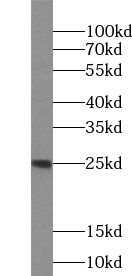Products
UBE2T/HSPC150 antibody
Category:
Research Area:
- SPECIFICATIONS
- Product Name
- UBE2T/HSPC150 antibody
- Catalogue No.
- FNab09185
- Size
- 100μg
- Form
- liquid
- Purification
- Immunogen affinity purified
- Purity
- ≥95% as determined by SDS-PAGE
- Clonality
- polyclonal
- Isotype
- IgG
- Storage
- PBS with 0.02% sodium azide and 50% glycerol pH 7.3, -20℃ for 12 months(Avoid repeated freeze / thaw cycles.)
Immunogen
- Immunogen
- ubiquitin-conjugating enzyme E2T(putative)
- Alternative Names
- HSPC150 antibody, PIG50 antibody, UBE2T antibody, Ubiquitin carrier protein T antibody, Ubiquitin protein ligase T antibody
- UniProt ID
- Q9NPD8
- Observed MW
- 24 kDa
Application
- Tested Applications
- ELISA, WB, IP
- Recommended dilution
- WB: 1:200-1:2000; IP: 1:200-1:2000
Validated Images
 Jurkat cells were subjected to SDS PAGE followed by western blot with FNab09185(UBE2T antibody) at dilution of 1:800
Jurkat cells were subjected to SDS PAGE followed by western blot with FNab09185(UBE2T antibody) at dilution of 1:800
 IP Result of anti-UBE2T/HSPC150 (IP:FNab09185, 3ug; Detection:FNab09185 1:500) with HeLa cells lysate 3000ug.
IP Result of anti-UBE2T/HSPC150 (IP:FNab09185, 3ug; Detection:FNab09185 1:500) with HeLa cells lysate 3000ug.
- Background
- The ubiquitin(Ub)-mediated protein degradation pathway involves three sequential enzymatic steps that facilitate the conjugation of Ub to specific protein substrates. The first step requires ATP-dependent activation of the C-terminus of Ub and the assembly of multi-Ubs by Ub-activating enzyme E1. The ubiquitin-conjugating enzyme E2, catalytic(UBCc) domain, is then conjugated to Ubs, through a thiol-ester linkage between a conserved cysteine and the C-terminus of Ub, to generate an intermediate Ub-E2 complex. Then the E3, a ligase, catalyzes the transfer of Ub from E2 to the appropriate substrate. This pathway regulates many fundamental cellular processes. There are also other E2s which form thiol-ester linkages without the use of E3s as well as several UBC homologs(TSG101, Mms2, Croc-1 and similar proteins), which lack the active site cysteine essential for ubiquitination and appear to function in DNA repair pathways.



